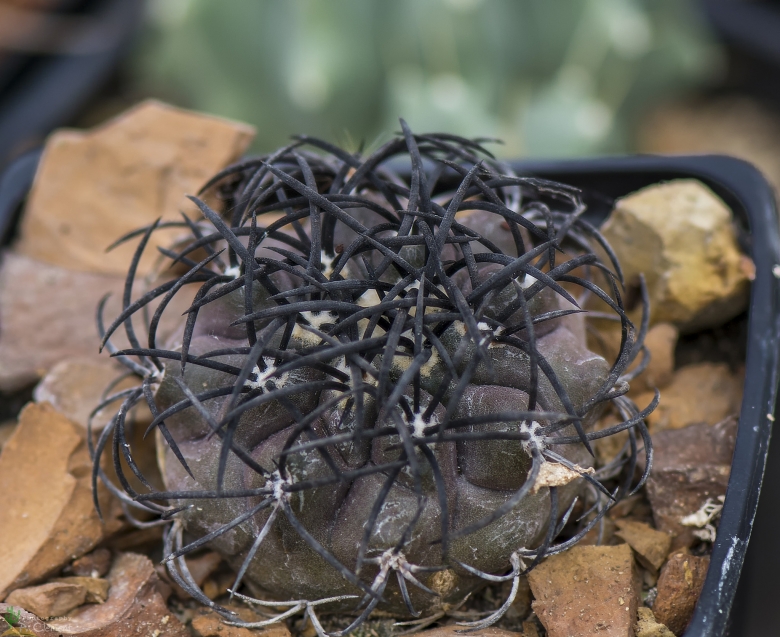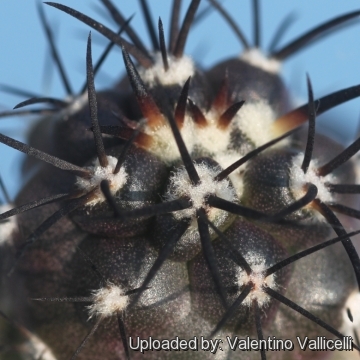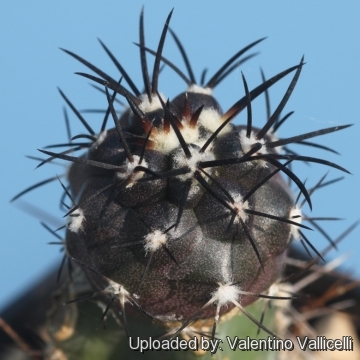
Copiapoa griseoviolacea Photo by: Peiffer Clement
Origin and Habitat: South of Huasco River ( south Freirina), region 03 Atacama, Central Chile (Southern South America)
Altitude: 320-830 m.
Habitat: Copiapoa griseoviolaceaSN|23780]]SN|23780]] grows abundantly at the bottom of hills in the dry river banksof the Huasco River with few sparse specimens scattered on up to the top of the hill.
Synonyms:
Description: Copiapoa griseoviolaceaSN|1109]]SN|23780]] appears to be an attractive southern form of Copiapoa duraSN|14234]]SN|14234]] (Copiapoa echinoidesSN|23780]]SN|1109]]) from which it differs by its epidermis and dense spine covering. It may grow solitary or often in more or less dense clumps.
Stem: Spherical-flattened, firm, woolly apically, epidermis dark tannish-green densely covered by a thick farinose violet-grey layer of wax, hence the name.
Spines: Anthracite grey, stout, curved inward and interlacing.
Subspecies, varieties, forms and cultivars of plants belonging to the Copiapoa echinoides group
 Copiapoa bridgesii (Pfeiff.) Backeb.: has very spiny, cylindrical stems. Its relationship with Copiapoa echinoides is unclear. It is probably a good species rather than a variety of C. echinoides. Distribution: North of Chanaral, Atacama, Chile.
Copiapoa bridgesii (Pfeiff.) Backeb.: has very spiny, cylindrical stems. Its relationship with Copiapoa echinoides is unclear. It is probably a good species rather than a variety of C. echinoides. Distribution: North of Chanaral, Atacama, Chile. Copiapoa cupreata (Poselg. ex Rümpler) Backeb.
Copiapoa cupreata (Poselg. ex Rümpler) Backeb. Copiapoa dura F.Ritter: Solitary, or forming dense clumps. The stem is firm, dark tannish-green to very dark-purple and woolly apically. The spines are very strong maroon-reddish to pure black, straight or (usually) somewhat curved upward.
Copiapoa dura F.Ritter: Solitary, or forming dense clumps. The stem is firm, dark tannish-green to very dark-purple and woolly apically. The spines are very strong maroon-reddish to pure black, straight or (usually) somewhat curved upward. Copiapoa echinoides (Lem.) Britton ex Rose in Britton & Rose: small growing plant with dark purplish-brown stem and thick curved amber-maroon to black spines. This appears to be a very variable species.
Copiapoa echinoides (Lem.) Britton ex Rose in Britton & Rose: small growing plant with dark purplish-brown stem and thick curved amber-maroon to black spines. This appears to be a very variable species. Copiapoa echinoides var. cuprea (F.Ritter) A.E.Hoffm.: Stems dull green to dark coppery-brown and woolly apically spines, stout bwown to black, straight to somewhat curved upward.
Copiapoa echinoides var. cuprea (F.Ritter) A.E.Hoffm.: Stems dull green to dark coppery-brown and woolly apically spines, stout bwown to black, straight to somewhat curved upward. Copiapoa griseoviolacea I.Schaub & Keim: has a dark farinose violet-grey epidermis and a dense spine covering. Distribution: south of the Huasco river.
Copiapoa griseoviolacea I.Schaub & Keim: has a dark farinose violet-grey epidermis and a dense spine covering. Distribution: south of the Huasco river.
 Copiapoa griseoviolacea Photo by: Valentino Vallicelli
Copiapoa griseoviolacea Photo by: Valentino Vallicelli Copiapoa griseoviolacea Photo by: Peiffer Clement
Copiapoa griseoviolacea Photo by: Peiffer Clement Copiapoa griseoviolacea Photo by: Valentino Vallicelli
Copiapoa griseoviolacea Photo by: Valentino VallicelliSend a photo of this plant.The gallery now contains thousands of pictures, however it is possible to do even more. We are, of course, seeking photos of species not yet shown in the gallery but not only that, we are also looking for better pictures than those already present.
Read More... Cultivation and Propagation: The location has to be warm and bright, and it has to be in direct sun. Otherwise the bodies tend to elongate in cultivation, but they should be protected from excessive heat and sun in summer. In the spring and late summer, water moderately. Between these times there are dry rest periods. In the winter keep the plant absolutely dry. The roots need a lot of room, so make sure that the pot is large enough. Use regular cacti soil with very good drainage.
Keep warm and dry in winter (10°C) to avoid rot. Not highly tolerant of a great deal of frost. (Frost tolerance 0°C)
Propagation: Seeds (offsets rarely), Grafting is often used to speed growth rate of seedlings and to create a back-up to plants in collection.













